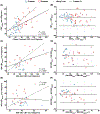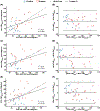Quantitative perfusion mapping with induced transient hypoxia using BOLD MRI
- PMID: 32767413
- PMCID: PMC7728454
- DOI: 10.1002/mrm.28422
Quantitative perfusion mapping with induced transient hypoxia using BOLD MRI
Abstract
Purpose: Gadolinium-based dynamic susceptibility contrast (DSC) is commonly used to characterize blood flow in patients with stroke and brain tumors. Unfortunately, gadolinium contrast administration has been associated with adverse reactions and long-term accumulation in tissues. In this work, we propose an alternative deoxygenation-based DSC (dDSC) method that uses a transient hypoxia gas paradigm to deliver a bolus of paramagnetic deoxygenated hemoglobin to the cerebral vasculature for perfusion imaging.
Methods: Through traditional DSC tracer kinetic modeling, the MR signal change induced by this hypoxic bolus can be used to generate regional perfusion maps of cerebral blood flow, cerebral blood volume, and mean transit time. This gas paradigm and blood-oxygen-level-dependent (BOLD)-MRI were performed concurrently on a cohort of 66 healthy and chronically anemic subjects (age 23.5 ± 9.7, female 64%).
Results: Our results showed reasonable global and regional agreement between dDSC and other flow techniques, such as phase contrast and arterial spin labeling.
Conclusion: In this proof-of-concept study, we demonstrated the feasibility of using transient hypoxia to generate a contrast bolus that mimics the effect of gadolinium and yields reasonable perfusion estimates. Looking forward, optimization of the hypoxia boluses and measurement of the arterial-input function is necessary to improve the accuracy of dDSC. Additionally, a cross-validation study of dDSC and DSC in brain tumor and ischemic stroke subjects is warranted to evaluate the clinical diagnostic utility of this approach.
Keywords: arterial spin labeling; deoxyhemoglobin contrast; dynamic susceptibility contrast; phase contrast; transient hypoxia.
© 2020 International Society for Magnetic Resonance in Medicine.
Figures






Similar articles
-
Investigations of hypoxia-induced deoxyhemoglobin as a contrast agent for cerebral perfusion imaging.Hum Brain Mapp. 2023 Feb 15;44(3):1019-1029. doi: 10.1002/hbm.26131. Epub 2022 Oct 29. Hum Brain Mapp. 2023. PMID: 36308389 Free PMC article.
-
Contrast-free dynamic susceptibility contrast using sinusoidal and bolus oxygenation challenges.NMR Biomed. 2024 May;37(5):e5111. doi: 10.1002/nbm.5111. Epub 2024 Jan 31. NMR Biomed. 2024. PMID: 38297919 Free PMC article.
-
Assessing Perfusion in Steno-Occlusive Cerebrovascular Disease Using Transient Hypoxia-Induced Deoxyhemoglobin as a Dynamic Susceptibility Contrast Agent.AJNR Am J Neuroradiol. 2023 Dec 29;45(1):37-43. doi: 10.3174/ajnr.A8068. AJNR Am J Neuroradiol. 2023. PMID: 38164571 Free PMC article.
-
Hypoxia imaging in brain tumors.Neuroimaging Clin N Am. 2002 Nov;12(4):537-52. doi: 10.1016/s1052-5149(02)00029-1. Neuroimaging Clin N Am. 2002. PMID: 12687910 Review.
-
Measurement of cerebral perfusion with arterial spin labeling: Part 1. Methods.J Int Neuropsychol Soc. 2007 May;13(3):517-25. doi: 10.1017/S1355617707070646. J Int Neuropsychol Soc. 2007. PMID: 17445301 Review.
Cited by
-
Functional magnetic resonance imaging reveals dysfunction of the paraspinal muscles in patients with chronic low back pain: a cross-sectional study.Quant Imaging Med Surg. 2023 Jun 1;13(6):3416-3427. doi: 10.21037/qims-22-1106. Epub 2023 Apr 10. Quant Imaging Med Surg. 2023. PMID: 37284106 Free PMC article.
-
Mapping cerebral perfusion in mice under various anesthesia levels using highly sensitive BOLD MRI with transient hypoxia.Sci Adv. 2024 Mar;10(9):eadm7605. doi: 10.1126/sciadv.adm7605. Epub 2024 Feb 28. Sci Adv. 2024. PMID: 38416820 Free PMC article.
-
Investigations of hypoxia-induced deoxyhemoglobin as a contrast agent for cerebral perfusion imaging.Hum Brain Mapp. 2023 Feb 15;44(3):1019-1029. doi: 10.1002/hbm.26131. Epub 2022 Oct 29. Hum Brain Mapp. 2023. PMID: 36308389 Free PMC article.
-
Sinusoidal CO2 respiratory challenge for concurrent perfusion and cerebrovascular reactivity MRI.Front Physiol. 2023 Feb 9;14:1102983. doi: 10.3389/fphys.2023.1102983. eCollection 2023. Front Physiol. 2023. PMID: 36846345 Free PMC article.
-
Brain metastases: the role of clinical imaging.Br J Radiol. 2022 Feb 1;95(1130):20210944. doi: 10.1259/bjr.20210944. Epub 2021 Dec 14. Br J Radiol. 2022. PMID: 34808072 Free PMC article. Review.
References
-
- Shiroishi MS, Castellazzi G, Boxerman JL, et al. Principles of T2*-weighted dynamic susceptibility contrast MRI technique in brain tumor imaging. J Magn Reson Imaging. 2015;41:296–313. - PubMed
-
- Yamada K, Wu O, Gonzalez RG, et al. Magnetic resonance perfusion-weighted imaging of acute cerebral infarction: effect of the calculation methods and underlying vasculopathy. Stroke. 2002;33:87–94. - PubMed
-
- Young GS. Advanced MRI of adult brain tumors. Neurol Clin. 2007;25:947–973. - PubMed
-
- Beaumont A, Fatouros P, Gennarelli T, Corwin F, Marmarou A. Bolus tracer delivery measured by MRI confirms edema without blood-brain barrier permeability in diffuse traumatic brain injury. Acta Neurochir Suppl. 2006;96:171–174. - PubMed
Publication types
MeSH terms
Substances
Grants and funding
LinkOut - more resources
Full Text Sources
Other Literature Sources
Medical

